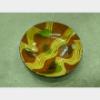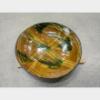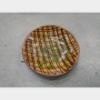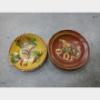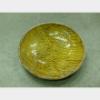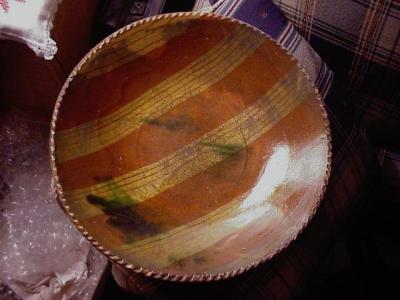Pie plates were a common everyday item used in the kitchen for centuries in Europe. In Colonial Pennsylania, potters were influenced by traditional German sgraffito plates. Sgraffito is a technique in which the body of a pot is covered with slip of a different color clay. The coating is carved away exposing the under body color of the pot. Slipware usually occurs as an earthenware core that has been decorated with slip or liquid clay. Slipware was introduced to this country by the Netherlands in the late sixteenth and early seventeenth centuries. Soon after the English Staffordshire tradition was born. Slipware began to be made in Sussex, Kent Somerset and Devon Counties. The wares produced in these English counties also influenced the local American potteries that produced earthenware pie plates. I am guessing that local earthenware pie plate production started soon after Colonial settlement in Philadelphia. These wares were not difficult to make and were essential to everyday life. Raw materials such as clay and wood, for firing, were abundant in the surrounding area. Whole Colonial examples of slipware or sgraffito pie plates are very rare. The earliest example I have seen at the Philadelphia Museum of Art is from 1792. There is an entire reference book documenting the Museum's extensive collection. Most of the plates seen in this photo album are c1840-60. Most are dug from privies in Philadelphia and restored. In about 1860 the popularity of earthenware decorated vessels and plates plummeted. People began to favor the cleaner looking yellow ware pottery made famous by the Bennington, NH potteries. The Bennington style pottery was fired to a higher temperature and resisted under glaze staining much better that the lower fired earthenware red pie plates.
« previous
|
next »
An Unbelievable Find
This 13 5/8th inch Philadelphia Charger was unearthed in one piece in the early 1970s in Little Egg Harbor. It was found in a turn of the century bottle dump on the property of an early dwelling. Apparently this c1825 charger was discarded about 1900 - 1910 and remained in the ground for 60 -70 years. When a creek beach was expanded to create a larger play area for some children, the dump was disturbed and this charged popped out of the ground whole with not as much as a glaze flake of damage. It was buried under a small tree.
Comments (0) | Add a Comment

